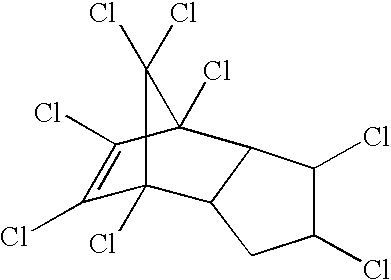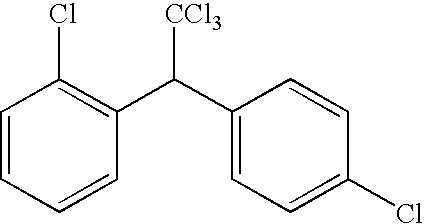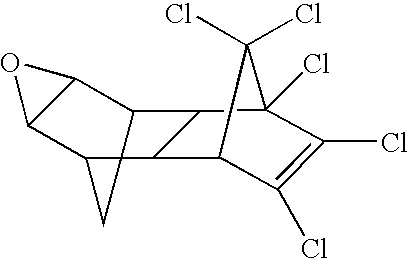Compounds that act to modulate insect growth and methods and systems for identifying such compounds
a technology of compound and insect growth, applied in the field of compound that acts to modulate insect growth and methods and systems for identifying such compounds, can solve the problem of unresolved functional analogies between fxr/rxr and ecr/usp, and achieve the effects of enhancing plant ability, low impact on colocalized non-pest insects, and high potency for a targeted pest species
- Summary
- Abstract
- Description
- Claims
- Application Information
AI Technical Summary
Benefits of technology
Problems solved by technology
Method used
Image
Examples
example 1
Materials and Methods
[0177] A. Cell Growth Conditions
[0178] Chinese hamster ovary (CHO K1) cells were grown in Dulbecco's modified Eagle medium: nutrient mixture F-12 (1:1) containing 5% fetal bovine serum and supplemented with 50 u / ml penicillin, and 50 μg / ml streptomycin (Life Technologies) in a water-jacketed incubator held at 37° C. and maintained with a 5% CO2 atmosphere.
[0179] B. Chemicals
[0180] Chemicals were purchased from Sigma-Aldrich Chemical Company (St. Louis, Mo.) unless noted. Plant oils were manufactured by Aura Cacia (Weaverville, Calif.). Juvocimene was synthesized as described (Mestres, R. and E. Munoz, 1996, Synthetic Comm., 26:1309-1319). Myristicin, apiole, bergamotin, tangeretin, bisabolol, and cucurbitacin were obtained from Indofine Chemical Company (Somerville, N.J.). Methyleugenol was provided by the Batelle Chemical Company (Columbus, Ohio). Man-made insecticides were purchased from Chem Service (West Chester, Pa.). The precocene-like suicide substrat...
example 2
Description of Plasmid Vectors
[0187] Expression plasmids encoding Drosophila EcR (CMX-EcR), Drosophila USP (CMX-USP), rat FXR (CMX-FXR), human RXRα (CMX-hRXRα), glucocorticoid receptor (CMX-GR), and a glucocorticoid receptor trans-activating domain fused to an ecdysone DBD and LBD (CMX-GEcR) have been described (Yao et al., 1992, Cell, 71: 63-72; Yao et al., 1993, Nature 366:476-478; and Forman, B. M., 1995, Cell, 81: 687-693). The expression plasmids are constructed by inserting restriction fragments contining the appropriate coding sequence for the gene to be expressed into the CMXPL1 plasmid. For HRXRα, an EcoRI fragment of human RXR-α (hRXRα) was subcloned into the CMXPL1 plasmid.
[0188] The FXR expression vector (pRS-rFXR) contains DNA sequences encoding a constitutively active promoter derived from the Rous sarcoma virus long terminal repeat (LTR) fused to the complementary DNA sequence encoding the rat farnesoid-X-activated receptor (Forman et al., Cell 1995; NCBI Accession ...
example 3
JHIII Potentiates Ecdysteroid-Induced Transcriptional Activity in a Mammalian Cell Line Transfected With EcR.
[0197] In an initial series of studies, a GRdEcR chimera that consists of the rat glucocorticoid receptor (GR) activation domain attached to the EcR DBD and LBD (FIG. 1) was cotransfected along with mRXRα into CHO cells. The response of transfected cells to murA was measured using a (EcRE)5-ΔMTV-CAT reporter plasmid that carries five tandem repeats of the hsp27 EcRE linked to the MTV (mouse mammary tumor virus) promoter and the chloramphenicol acetyltransferase gene (CAT).
[0198] Results of a typical experiment are shown in FIG. 2. Cotransfection with GrdEcR and RXR evoked a detectable response at dosages as low as 0.1 μM murA. It was found that juvenile hormone III (JHIII) potentiated the response of murA in a dose-dependent manner (using 20, 40, 80, and 160 μM JHIII) at submaximal murA dosages (0.1 μM and 1 μM murA) (FIG. 2, sets 2 and 3, respectively). JHIII did not displ...
PUM
 Login to View More
Login to View More Abstract
Description
Claims
Application Information
 Login to View More
Login to View More - R&D
- Intellectual Property
- Life Sciences
- Materials
- Tech Scout
- Unparalleled Data Quality
- Higher Quality Content
- 60% Fewer Hallucinations
Browse by: Latest US Patents, China's latest patents, Technical Efficacy Thesaurus, Application Domain, Technology Topic, Popular Technical Reports.
© 2025 PatSnap. All rights reserved.Legal|Privacy policy|Modern Slavery Act Transparency Statement|Sitemap|About US| Contact US: help@patsnap.com



